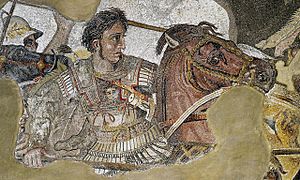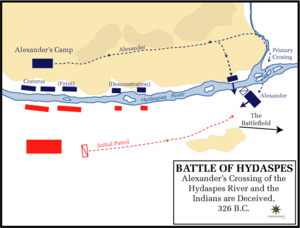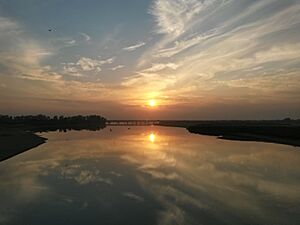Boukephala and Nikaia facts for kids
Boukephala and Nikaia were two ancient cities built by Alexander the Great, a famous king from Macedonia. He founded these cities around 326 BC during his journey through what is now Pakistan. The cities were located on opposite sides of the Hydaspes River, known today as the Jhelum River.
Alexander built these cities right after a big battle where he defeated an Indian king named Porus. One city was likely named Nikaia, meaning "victory," because it was built on the battlefield. The other city, Boukephala, was probably named after Alexander's beloved horse, Bucephalus, who passed away around that time. Craterus, one of Alexander's top generals, oversaw the building of these new settlements.
Even though these cities faced challenges like heavy monsoon rains, Boukephala became quite well-known. It was mentioned in ancient writings by people like Pliny the Elder and Ptolemy, and even appeared on old maps. Today, the exact spots where these cities stood are not fully known. However, many experts believe Boukephala was near modern Jalalpur, and Nikaia was across the river near Mong.
Alexander's Journey and City Building
Alexander the Great was a powerful king who led his army from Macedonia to conquer many lands. He defeated the Persian Empire and then moved towards India. In 326 BC, he reached the Hydaspes River (now the Jhelum River) in what is now Pakistan. Here, he fought a major battle against King Porus and won.
After this victory, Alexander decided to build two new cities. These cities were named Nikaia and Boukephala. They were built on opposite sides of the Hydaspes River. Craterus, one of Alexander's trusted generals, was in charge of building these cities. They were built quite quickly because many people were available to help.
Alexander celebrated his victory with games and horse contests near the western city. A few months later, his army wanted to turn back, so Alexander returned to the cities. His soldiers helped repair damage caused by the heavy monsoon rains. These rains were new to the Macedonians, and their buildings weren't ready for such weather.
Historians wonder if Alexander wanted these cities to grow into big trading centers or if they were mainly military bases. Since they were on a major river, they might have been important for trade routes. Alexander also founded many other cities, but Boukephala and Nikaia were special because they weren't built near existing forts or capitals.
Naming the Cities and Bucephalus

There is some mystery about which city was named Nikaia and which was Boukephala. Most historians think Nikaia, meaning "victory," was the city built on the eastern side, where the battle happened. Boukephala was likely named after Alexander's famous horse, Bucephalus.
The exact time of Bucephalus's death is also a bit unclear. Some ancient writers said he died during the battle. Others, like Plutarch and Arrian, wrote that he died later from old age, as he was around thirty years old. It's likely that the horse only died after Alexander had moved further east, and the cities were named when Alexander returned to the area.
What Happened to the Cities Later?
Boukephala continued to exist for several centuries after Alexander. It was likely part of the Mauryan Empire and later the Indo-Greek kingdom. These empires helped the city to survive and perhaps even thrive.
Many ancient Greco-Roman writers mentioned Boukephala. It appeared in stories about Alexander and in the works of famous geographers like Ptolemy and Pliny the Elder. It was even shown on old maps, like the Tabula Peutingeriana. A 13th-century Islamic scholar, Yaqut al-Hamawi, also wrote about it.
Nikaia, the other city, is mentioned less often in ancient records. Some historians think that another name, "Alexandria for Porus," might actually refer to Nikaia. Alexander often named cities after himself (Alexandria) or after his victories.
Where Were These Cities Located?
Even in ancient times, people debated the exact locations of Boukephala and Nikaia. The Jhelum River has changed its path over many centuries. This makes it hard to find the original sites today. Also, the heavy monsoon rains likely damaged the cities long ago.
Today, many experts believe Boukephala is located beneath the modern town of Jalalpur Sharif. An archaeologist named Aurel Stein suggested this in 1932. A monument honoring Alexander was built near Jalalpur between 1998 and 2011. It was supported by the Government of Pakistan, the Greek embassy, and private donations.
Since Boukephala was across the river from Nikaia, if Boukephala was at Jalalpur, then Nikaia was probably near the town of Mong. Mong is about 10 kilometers (6 miles) east across the river. This idea was first suggested by Alexander Cunningham.
Interestingly, an old Buddhist text called the Mulasarvastivada Vinaya might mention these cities. It talks about two cities on the Vitastā (Hydaspes) River. One was called "Place of the First Kingship" and the other "Place of the Good Horse." These names could be referring to Nikaia and Boukephala. There's also an old Hindu story about a magical horse dying near Jalalpur, which might connect to the legend of Bucephalus.



